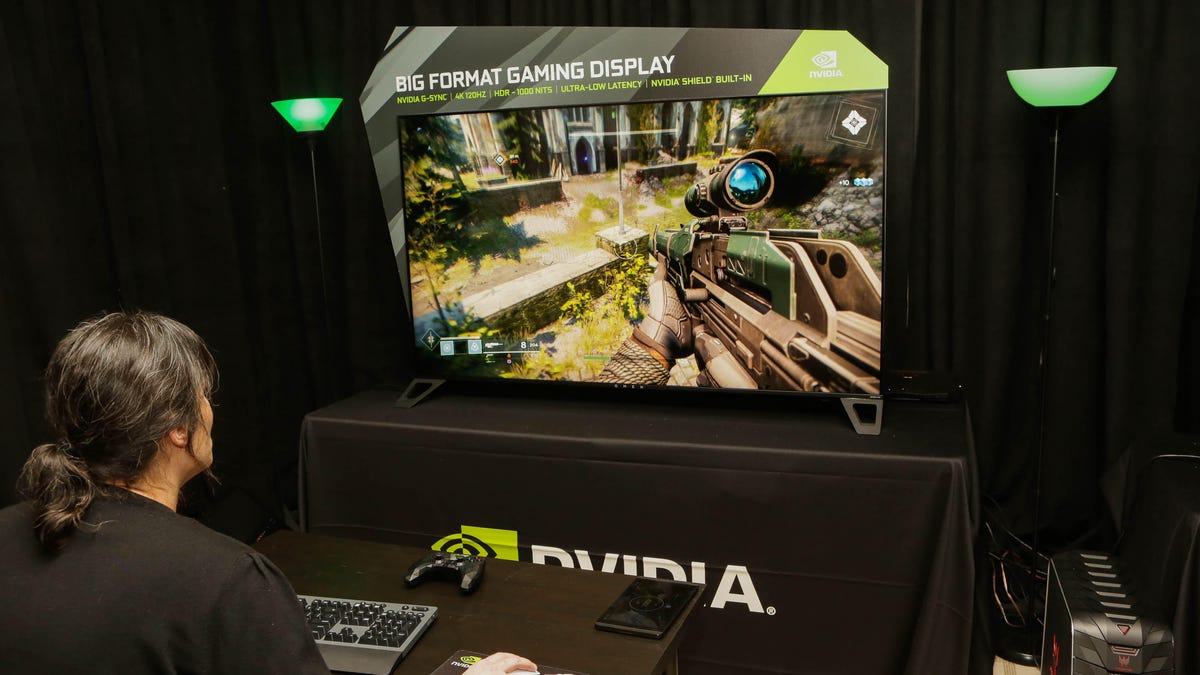Nvidia BFGD monitor is 65 inches of 4K HDR gaming glory
The G-Sync-equipped Big Format Gaming Display promises high-end gaming performance on a huge screen, with an Nvidia Shield built in.

The Nvidia BFGD.
Ever wondered why high-performance, low-latency gaming monitors can't be huge? Or why big TVs can't be designed specifically for gaming?
The Nvidia BFGD is both, and it could be a big freaking deal for gamers who want the ultimate plus-size display.
That abbreviation actually stands for Big Format Gaming Display, a "monitor" built by Nvidia along with partners HP, Asus and Acer. "Big Format" because this monitor is 65 inches, the size of a living-room TV, not the relatively puny 30-something-inch desktop monitor most PC gamers are chained to.
A TV built for gaming
The BFGD's gaming chops come courtesy of Nvidia's G-Sync technology, which employs variable refresh rates to synchronize a display's refresh rate and gameplay frame rates to prevent artifacts like tearing and stutter. Nvidia claims a "highly responsive, smooth, tear-free, immersive gaming experience unmatched by any display of this size." The company claims the same level of ultralow latency found in G-Sync-equipped PC monitors such as the LG 34UC89G.
In our experience, like all adaptive sync technologies, the effectiveness of G-Sync can be hit or miss. But there's no doubt it's needed, and blown up to 65 inches, artifacts such as stutter and tearing will likely be more visible.
To benefit from the BFGD's G-Sync it must be connected to a PC equipped with a compatible Nvidia card directly, using its DisplayPort connection. Despite the fact that it uses variable refresh rate, a feature in the new HDMI 2.1 specification, the HDMI inputs on the BFGD are version 2.0b, not 2.1. That's too bad, because HDMI 2.1 is great for big-screen PC gaming.
Nvidia says the monitor delivers low latency for other sources too, including Android gaming on Nvidia Shield (see below), external game consoles and PCs connected via Nvidia's GameStream technology. It did not cite an input lag number, however.
The monitor has a native 120Hz refresh rate, not the fake "effective" 120Hz found on many TVs. That's a lower native rate than many gaming monitors have -- that LG 34UC89G we mentioned is 144Hz, up to 166Hz with overclocking, for example, and we've seen them as high as 240Hz (the Acer Predator XB272) -- but as good as any 65-inch TV on the market.
Unlike just about every monitor available, the BFGD supports true high dynamic range (HDR) for games and other video sources rather than just mapping HDR content down to lower brightness levels and a smaller gamut ("compatibility"). Its direct-backlit LED display can get up to 1,000 nits in brightness and achieve the DCI-P3 color gamut, specs comparable to those of many high-end TVs today. By way of comparison, that LG monitor can get up to 320 nits, and we'll be seeing a lot of monitors claiming HDR capability thanks to the recent diluted specification.
Of course the BFGD has 4K resolution. It also utilizes full-array local dimming and while Nvidia didn't claim an actual number of dimmable zones, a rep did hint it was more than 300. It uses a VA LCD panel, which in our experience delivers superior contrast to IPS LCD panels. It supports HDR10 but not Dolby Vision.
Since it's a monitor and not a TV, there's no built-in TV tuner for over-the-air antenna broadcasts.
Specifications on the BFGD are still being finalized.
Nvidia Shield gaming streamer built in
On top of its display prowess, the BFGD builds in all the streaming and gaming goodness of the Android TV-powered, Google Assistant-equipped Nvidia Shield. One of the most powerful streamers on the market, the Shield is basically a video geek's dream machine, with stuff like 4K HDR streaming of Netflix, Amazon and others, NAS access, native Kodi support, Plex server capability, HD HomeRun integration and much more.
Nvidia says the BFGD's variable frame rate can match the 23.976, 24 and 25 FPS formats exactly, which could help sources based on those rates look closer to the director's intent. The company bundles the Shield remote and game controller with the TV, the latter with a far-field mic for hands-free "OK, Google" access to Google Assistant.
Specifications on the BFGD are still being finalized. Nvidia says its partners Asus, Acer and HP will ship the BFGD later this summer, and pricing was not announced.
What to expect from the big screens of 2018: From OLED to QLED to Micro LED, CES is the place where screen time is absolutely friggin' huge. Here's a peek.
CES 2018: CNET's complete coverage of tech's biggest show.



